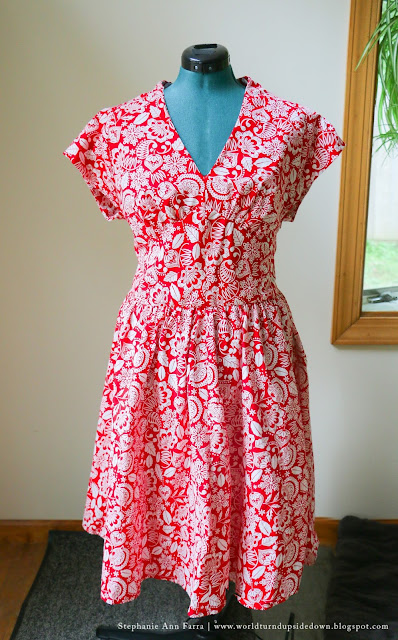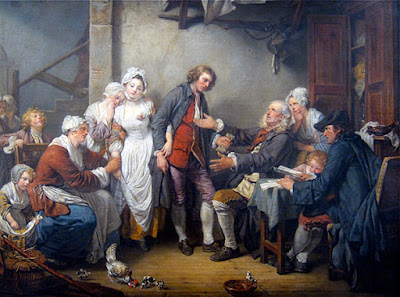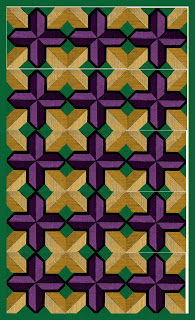Corsets or stays were worn in the 19th century by nearly all women of all classes. They were used to move the bust line upwards in a high position and to create a smooth line at the waist. They also had the more practical application of helping support the back when lifting and to support the weight of the clothing. During the Civil War Era, it was not common for women to drastically alter their waist. Small waists were created during this time period by lower shoulder seams, which visually enlarged the shoulders and by the large skirts. In comparison to the wide looking shoulders and large skirts, waists looked a lot smaller.
It is very obvious when someone in Civil War Era clothing is not wearing a corset. Almost all women wore corsets, even when they were pregnant. There were specially designed corsets which allowed for a protruding belly. You can see a nicely reproduced maternity corset at
A Day in 1862.
These instructions and this pattern were printed in both Godey's Lady's Book (1857) and Arthur's Home Magazine (1858.) It was a common practice at the time to share material between magazines which were likely to have a different readership, frequently being from different countries or regions. In this case, Arthur's Home Magazine was a magazine also based in Philadelphia and the editor also wrote stories for Godey's Lady's Book. The instructions call for whalebone but most "boning" was actually baleen (the filtering keratin) from baleen whales. Today many people use metal boning, plastic boning and sometimes even
"zip ties," due to their cheap cost.
"Materials necessary for making a pair of Stays.— Half a yard of Coutille; a piece of stay tape for casing ; some whalebone, either ready prepared or in strips to be split and shaved to size ; a steel busk; wash-leather sufficient to cover it, and webbing to case it; a paper of 8-between needles ; a reel of 28-cotton ; a box of French holes; and a punch for putting them in.*
DIRECTIONS FOR TAKING THE MEASURE.
Measure round the waist as tightly as possible, noticing the number of inches; deduct two as an allowance for the clothes. Next take the measure of the bust, by placing the measure in the middle of the chest, at No. 1, (see engraving,) and pass it over the bosom to No. 8, not tightly, and no allowance here to be made for the clothes.
Then, from No. 8, passing the measure closely under the arm, to No. 1 of the back, which is not to reach the middle of the back by an inch and a half. Next, place the measure at the bottom of the busk, and pass round stomach and hips, allowing about four inches for clothes, and then take the length of the busk.
It will be found to simplify the directions very much, if a form similar to the following be first prepared, and the number of inches written against each as the part is measured, and then no confusion can possibly take place in the cutting out:
Waist,
Bust,
Back,
Hips,
Length of Busk.
* If preferred, any stay-maker will put them in at a trifling expense.
DIRECTIONS FOR CUTTING OUT.
A pattern must now be prepared according to the directions given in the engraving, which can easily be done by enlarging the design, and adding the requisite number of inches between each figure.
The Back.—Double the Coutille sufficiently wide to take two whalebones, the holes, and to turn in for felling down, as marked in the engraving ; then lay on the pattern, and cut out the two parts of the back together, allowing, for turnings-in, about half an inch at the seam under the arm.
The Front is cut out by placing the pattern so that the straight way comes in the direction of the little bones up the bosom, leaving a good turning-in up the front seam, which crease off in pattern on the double Coutille, as it is better to cut out every part in the double, that you may have each side exactly alike.
Should you desire to increase the size of the stays, it must always be done by allowing the required additional size on the front and back at the seam under the arm, and by proportioning the armhole to the increased size.
When the bosom gores are to be put in, the Coutille is merely cut from No. 2 to No. 3, and from No. 5 to No. 6, in a direct line, cutting none away. In cutting places for stomach and hip-gores, in front and back, cut straight up, and then from No. 7 to No. 8 in back, and from No. 13 to No. 14 in front. Then cut out all the gores as directed in the engraving.
DIRECTIONS FOR MAKING.
1st.—Stitch a place for the first bone at back, and for the holes, the width of half an inch, keeping the line perfectly even by the rays in the Coutille, and fell down a place for the second bone on the wrong side.
2dly.—Fit the bosom gores by making a narrow turning-in from No. 2 to No. 3, and from No. 3 to No. 4; fix the gore at 3, the straight side of the gore next the busk, tacking it very closely up to No. 2; then fix the other gore in like manner at No. 6, the straight side next the arm-hole, tacking up to No. 7.
3dly.—With a measure, make the required size across the bust, by increasing or diminishing the gores at the top; tack the other sides very firmly from No. 3 to No. 4, and from No. 6 to No. 5, shaping them prettily, narrow at the bottom, and of a rounded form towards the top; then stitch them very neatly, and cutting away superfluous stuff on the wrong side, hem down, beginning each side from No. 3 to No. 6.
4thly.—Hem a piece of stay-tape at the back, for little bones, and stitch down the middle of it on the right side.The other half front to be done in a similar manner.
5thly.—Put in the stomach gores, turning in from 14 to 15, and tacking the straight side of the gore under it, and fix the hip gores in the back in like manner, the straight side to the holes.
6thly—Join the seams under the arm, by pinning No. 10 of half-front to No. 11 of half-back, to half the size of waist required, wrapping the front on to the back. Everywhere face each piece to its fellow piece, and crease it, that it may be exactly the same size and shape. Then do the other half in the same way.
7thly.—Having closed the seam, finish the stomach and hip gore, by measuring and making to the size required round the hip, by letting out or taking in, rounding them to fit the hip; face and crease the gores for the other half, which is to be finished in the same manner.
8thly.—Take a piece of webbing wide enough to case the busk when covered with wash-leather; double it exactly, and tack down the half-front, the double edge being scrupulously down the centre of the stays ; fell it on very closely. Then stitch the two halves together at the crease down the middle ; turn the other half of the webbing on to the unfinished side, and fell it down as before, turning in a little piece top and bottom, and finish.
9thly.—Bind the stays very neatly at top and bottom.
10thly.—Put in the holes, two near each other at the top of the right side, and two near each other at the bottom of the left side; the rest at equal distances.
Proceed now to the boning, which do by scraping them to fit nicely ; then, having covered them with a piece of glazed calico, cut at the bottom of each bone place a hole, like a buttonhole, and work it round like one. Put the bones in, and drill a hole through the stays and the bone, about an inch and a half from the top and bottom of each bone, and fasten them in with silk, by bringing the needle through the hole to the right side, and passing it over the top of the bone, as marked at No. 12. Then put in the busk, and if a hook is required at the bottom, put that in before the busk, which is best done by leaving a short hole in the seam, and passing the hook through, fastening it securely at the back. The busk must be stitched in very firmly top and bottom.
Should the stays have become soiled in the process of making, they are easily cleaned with bread, inside and out, and when cleaned, must be nicely pressed, taking care to make no creases anywhere.*
If these simple directions be strictly adhered to in the making up, a pair of well-fitting stays, at a trifling cost, will reward the pains of the worker, and which could not be obtained ready made under one guinea."
* It was common to remove a stain by cutting a slice off of a loaf of stale bread to expose the inside. The inside was rubbed against the stain until the bread absorbed some of the stain. Once the bread was too dirty to absorbed any more, a new slice was cut of and the process continued.


















































